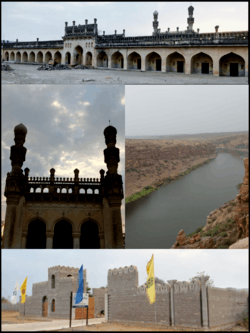Gandikota
| Gandikota | |
|---|---|
| Historical site | |
 Montage of Gandikota clockwise from top to bottom: Gandikota Fort Main Entrance, Grand Penna River Canyon, AP Tourism Resort, Jumma Masjid | |
 Gandikota Location in Andhra Pradesh, India  Gandikota Gandikota (India) | |
| Coordinates: 14°48′48″N 78°17′05″E / 14.813433°N 78.284757°ECoordinates: 14°48′48″N 78°17′05″E / 14.813433°N 78.284757°E | |
| Country |
|
| State | Andhra Pradesh |
| Established | 1369 A. D.[1] |
| Founded by | Pemmasani Kumara Timma Nayaka |
| Languages | |
| • Official | Telugu |
| Time zone | UTC+5:30 (IST) |
| PIN | 516434 |
| Telephone code | 08560 |
| Vehicle registration | AP03 |
| Website |
aptdc |
Gandikota is a village on the right bank of the river Pennar, 15 km from Jammalamadugu in Kadapa district, Andhra Pradesh, India. Gandikota is home for Kamma Kings who ruled this fort for nearly 300 years. Gandikota was ruled by powerful Telugu dynasty, the Pemmasani Kamma Dynasty also known as Gandikota Kammas, and was one of the most prominent forts in the country.[2]
Etymology
The fort of Gandikota acquired its name due to the 'gorge' (in Telugu it is called 'gandi'), formed between the Erramala range of hills, also known as Gandikota hills and the river Pennar that flows at its foot, reducing its width to a mere 300 ft (look for the river image in the montage/main image). Situated amidst beautiful landscape and wild forests, it is endowed with vast natural resources.
History
Early history
Gandikota area was first identified and made Sand fort in 1123 by Kapa Raja of nearby Bommanapalle village and a subordinate of Ahavamalla Someswara I, the Western Chalukyan king of Kalyana.
The village transformed into major fort after the emergence of the Pemmasani Nayaks.[3][4][5][6] Recently, Obul Reddy, a Mydukur-based historian, discovered a copper plate inscription on the history of Gandikonda Fort. The inscription dates back to 16th century.[7]
Vemana, the famous Telugu poet, native of Kadapa district and believed to have lived in Gandikota area for a short period.
Efforts are being put forth to give Gandikota a world heritage status.[8]
Major structures
 Ranganatha Swamy Temple
Ranganatha Swamy Temple Gandikota Fort Entrance
Gandikota Fort Entrance Gandikota Fort Mosque
Gandikota Fort Mosque Camping on the banks of Pennar river
Camping on the banks of Pennar river
In the fort are two ancient temples, dedicated to Madhava and Ranganatha. They are in ruins and the fort area is full of the debris of ages and many ancient structures in varying stages of decay. The large granary, with a vaulted roof, is now used as watchman's quarters. The Jamia Masjid has two adjacent minarets. A heritage festival is held every year in the fort area.[9]
The other structures in the fort, include another large granary, a magazine, a graceful 'pigeon tower' with fretted windows and an extensive palace built by bricks with some plastered decorations and some wells. There is an old cannon lying in the fort. There is the 'Rayalacheruvu' with its perennial springs irrigating some lime and plantain gardens. It is said that this 'Cheruvu' was connected to a fountain in Jamia Masjid by pipes, traces of which can still be seen.
There were other gardens and springs. There is an undated inscription on a boulder, near the 'Nagajhari' outside the fort, recording the gift of two gardens at the place to the temple. There was a garden called 'Parebagh' with a waterfall at the foot of the hills, on the bank of the Penneru.
There are multiple camping areas outside the Fort and on the banks of the Pennar river.
Access and transportation

The nearest railway station is 26 km away at Muddanuru (railway code: MOO) in Kadapa District. There are number of trains from Gooty Junction.
The nearest town is Jammalamadugu.[10] There are buses available from Jammalamadugu Old Bus Stand (Gandhi Statue Junction) to Gandikota.
Inside the fort there is no means of transportation except to walk by foot. It is ideal to engage a guide as the fort area is huge. There is a good downhill trek through the canyon that leads to the riverbed. There is a dam upstream (Gandikota Dam) and a dam downstream (Mylavaram Dam).
Developments
In November 2015, Chief Minister of Andhra Pradesh, Chandrababu Naidu, cited a plan to develop Gandikota as next major tourist hub of Andhra Pradesh.[11]
References
- ↑ Sri Krishna Deva Rayalu Vamsha Moolalu, Muthevi Ravindranath, 2017, Savithri Publications
- ↑ Reporter, Staff. "Stone from Gandikota fort to be used". The Hindu. Retrieved 2017-04-11.
- ↑ Sewell, Robert. "A Forgotten Empire (Vijayanagar): A contribution to the History of India".
- ↑ "K. A. Nilakanta sastry: Further Sources of Vijayanagar History". 1946.
- ↑ Stein, Burton (1989). Vijayanagara. Cambridge University Press. p. 92. ISBN 0-521-26693-9.
- ↑ "Tidings of the king: a translation and ethnohistorical analysis of the Rayavachakamu by Phillip B. Wagoner". Honolulu: University of Hawaii Press. 1993. pp. 138–139. ISBN 0-8248-1495-9.
- ↑ "Copper plate inscription about Gandikonda Fort found".
- ↑ "Heritage status for Gandikota fort sought". The Hindu. 21 April 2008. Retrieved 4 April 2014.
- ↑ "Gandikota Heritage festival from October 26". The Hindu. 19 September 2012. Retrieved 4 April 2014.
- ↑ http://www.mytraveltales.in/2013/09/trip-to-gandikota.html
- ↑ http://trekkerpedia.com/2015/11/gandikota-to-be-next-tourist-hub-of-andhra-pradesh/
Further reading
- Article about this visiting Gandikota: Grand Canyon at Gandikota, Deccan Chronicle newspaper (Hyderabad edition), 6 April 2012, Wanderlust Page: 21
External links
| Wikimedia Commons has media related to Gandikota. |
- Imperial Gazetteer of India: About Gandikota
- Water color paintings by Thomas Fraser and Sir Thomas Anburey-- in 1799 & 1802
- French Traveller Tavernier's experience about Gandikota Fort & about Nawab of Gandikota while he was in India